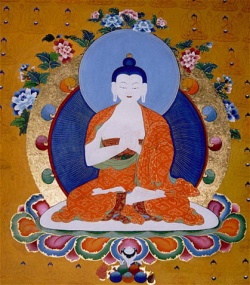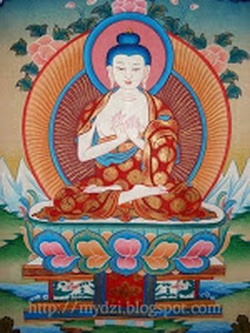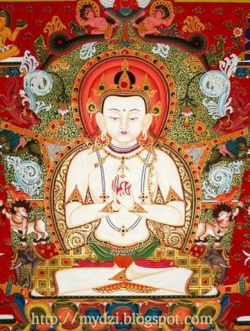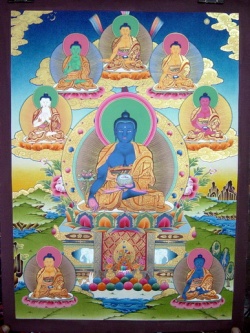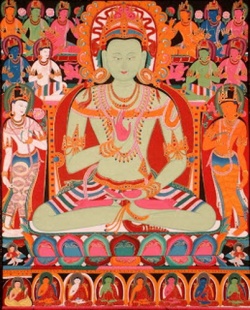The Five Wisdoms: the five Buddha families (by Thrangu Rinpoche)
The essential task of a Bodhisattva is to develop the Enlightened qualities of the Five Buddha Families, also called the five dhyani (Meditative) Buddhas. These qualities pervade and are part of every sentient being without exception, but they are masked. To achieve the realization of these Five Buddha Families, we must eliminate the five disturbing emotions (Skt. Kleshas): Anger, Attachment, Ignorance, pride and envy. When these disturbing emotions are pacified, the Wisdom of the Five Dhyani Buddhas can shine forth.
To begin to understand how to cultivate The Five Wisdoms, we have first to understand the five disturbing emotions. The first disturbing emotion, which is Anger or aggression, often appears to us to be the strongest of these five emotions. We develop Anger against a person or a situation that we dislike or that frustrates us. If we look at our Anger carefully, we will see that Anger is not good for us in the short term and it is also harmful to us in the long term. Anger is so powerful that it harms not only us, but others as well. In the short term, Anger leads to great conflict in this lifetime. In the long term, excessive Anger can lead to a Rebirth in a lower realm, because this emotion leads to the development of negative Karma. Because intense Anger can cause a negative Rebirth, Anger, not only causes Suffering and pain in this lifetime, but it also causes Suffering in the next lifetime, where even more intense Suffering ensues as a result. To be free of the experience of Suffering and pain in this lifetime and taking birth in a lower realm, it is necessary to employ methods to overcome and eliminate Anger and hatred.
When Anger is purified, we gradually begin to realize mirror-like Wisdom. With mirror-like Wisdom there is no distinction between self and other Phenomena. So everything is experienced in unity and Harmony. It is called mirror-like Wisdom because the Phenomena appear to the Mind in the same way that things appear in a clean mirror, completely accurate and with no distortion. Understanding and realizing mirror-like Wisdom can only take place in the absence of the negative emotion of Anger. This mirror-like Wisdom is classically characterized as the Wisdom of The Buddha Akshobhya, a Sambhogakaya Buddha who is blue in color. He holds a Vajra in his left hand and his activity is pacifying the emotions, in particular, Suffering, illness, frustration and sorrow.
When the obscuring emotion of pride is purified, the Wisdom of equality emerges. This Wisdom is associated with the second dhyani Buddha, The Buddha Ratnasambhava. As soon we are born, we develop a belief of self or ego which is Thinking, “I am separate from others.”
This Feeling of separation from others leads to the disturbing emotion of pride, because we begin to think that we are better or superior to others who are in a less fortunate position. From this, we begin to believe that there are desirable or “good” things, which others also use to believe that are good, and “bad” or undesirable things, which others also use to believe that are bad. This then leads to pride and Thinking that we are better than others are. As long as we hold onto this belief, we will never be able to learn from others.
To purify our pride we must give up our ego, clinging to develop the Wisdom of equality. When we are free from pride, the Wisdom of equality, which is associated with Buddha Ratnasambhava, begins to arise. This Dhyana Buddha is gold in color, with the color of gold representing his enriching qualities, and he holds a wish-fulfilling jewel in his hands.
When the disturbing emotions of Attachment or Desire are purified, it leads to the realization of discerning Wisdom. This Wisdom is associated with the third Dhyana Buddha, The Buddha Amitabha. The obscuring emotion of Desire causes much Suffering because Desire distracts us and keeps our Mind restless and busy. When we are attached to things, we are never satisfied and always crave for more and better things. Desire causes us to continually engage in work and activities to achieve and acquire our Mind’s Desires. Since we continually want more and often lose what we Desire, this Desire leads only to dissatisfaction in Life. By understanding this disturbing emotion and eliminating it, the third discerning Wisdom shines forth. By realizing this discerning Wisdom, the Enlightened Mind experience and become one with The Buddha Amitabha. It is with this Wisdom that we understand and have empathy for each and every living being and appreciate the qualities of others. The Buddha Amitabha’s nature is the absence of Attachment of Desire and his activity is magnetizing. As already described, Attachment or Desire lead to the Suffering of dissatisfaction, a state in which one always wants and strives for more and better things. Desire determines our behavior and not attaining what we Desire leads us to frustration and dissatisfaction. With the discerning Wisdom resulting from the realization ofBuddha Amitabha, there is no Attachment and Desire and thus no dissatisfaction or Craving for more and better things. This realization is so powerful that all things are naturally magnetized as our own, because we are fully identify with all.
The fourth Dhyana Buddha is The Buddha Amoghasiddhi. He is realized in the absence of the negative emotion of jealousy, which includes being jealous of others’ success and good Fortune. With this jealousy, negativity is accumulated. By overcoming jealousy, The Buddha Amoghasiddhiand the fourth all accomplishing Wisdom are realized.
Jealousy prevents and impedes an individual from accomplishing his or her own well being, and as a result he or she experiences more Suffering and continues developing further jealousy towards those who have more. This is the reason why all accomplishing Wisdom is experienced in the absence of jealousy, i.e., when jealousy is removed, all wishes are naturally and effortlessly accomplished.
As long as jealousy determines our attitude, we are bound to experience more obstacles in achieving personal success and in accomplishing positive goals. This is why Buddha Amoghasiddhi’s activity is wrathful. It is with decisively cutting that he removes all obstacles and hindrances preventing Spiritual maturation and success. He is green in color, the same color as growing plants, symbolizing the numerous activities he employs to remove hindrances.
The fifth Dhyana Buddha is Buddha Vairoçana, who is realized when the obscuring emotion of Ignorance is overcome. Ignorance is failing to recognize what is wholesome and unwholesome, failing to know the ultimate and conventional, Truth and failing to realize the highest state of the Dharmata, the one that has realized Dharmakaya. Ignorance is the root of the disturbing emotions so that, for example, it is only out of Ignorance that one becomes angry. We only act aggressively towards others because we are ignorant that Anger will only bring on pain and sorrow to ourselves and others. Likewise, it is only due Ignorance that we have pride, Desire, and jealousy.
Elimination of the darkness of Ignorance is the realization of Buddha Vairoçana. The Wisdom that shines forth when Ignorance is overcome is the Wisdom of the Dharmata, i.e., realization of the highest state. We have failed to realize the ways things really are up until now, because we possess Ignorance which cause our Mental confusion and leads to negative actions. Purification of Ignorance engenders realization of the Wisdom which sees the true nature of Phenomena.
The natural Body of the purity of the Wisdom of the Dharmata is Buddha Vairoçana. Since the darkness of Ignorance is eliminated in him, he is depicted as being white in color..
The Buddha Akshobya
The disturbing emotion of Anger is transformed into The Buddha Akshobhya’s Wisdom at Enlightenment. We may wonder how aggression or Anger relates to Buddha Akshobhya, who exhibits very peaceful activity. Or we may wonder how the absence of Anger results in the specific Buddha Akshobhya. To understand this, it is important to know that “Akshobhya” is a Sanskrit name, and when this was translated into Tibetan he was called Sangye Mikyodpa or the “immovable, stable and changeless Buddha.” He is called “immovable and changeless” because when it’s not realized and the disturbing emotion of Anger is present, everything changes: our Body shows disorders and the friend we are angry with becomes our enemy. When this Anger is purified, everything is peaceful and stable, which is the realization of the changeless, stable, permanent Buddha Akshobhya.
The dhyani Buddhas are colored in the five main colors of blue, red, yellow, green and white. The Buddha Akshobhya’s blue color has a symbolical meaning. Blue symbolizes permanence that is changeless, just as the sky has always been blue, whether this year or a thousand years ago. Buddha Akshobhya is blue to represent this changelessness. Furthermore, The Buddha Akshobhya holds a Vajra in his lap which is also a Symbol of his indestructible and changeless nature. He sits in the full Vajra (or full Lotus) posture to symbolize the indestructible nature and his right hand touches the Earth which is also a gesture of the changeless. In a Mandala, Akshobhya resides in the East and is on an elephant throne.
The Buddha Ratnasambhava
The Buddha Ratnasambhava has the quality of the Purification of pride. Ratnasambhava is the Sanskrit name, but in Tibetan he is called Sangye Rinchenjungdan.
The tibetan word sangye means “Buddha” and the word rinchen means “precious”, referring to all precious, good and immaculate things. The word jungdan means “the source.” So, Ratnasambhava is the source of all good qualities, with these precious qualities being the absence of pride. When ego and pride have been removed, we are open to receive all the positive Knowledge and qualities. This is the realization of Sangye Rinchenjungdan.
Knowing the meaning of Rinchenjungdan, we can understand why his activity encompasses the enrichment of all precious qualities of realization. Ratnasambhava resides in the south and is yellow or gold in color. The color gold represents Wealth and Ratnasambhava holds a wish-fulfilling jewel that gives a person everything that he or she Desires, so this also symbolizes enrichment. He is seated in the Vajra posture of fulfillment on a Horse’s throne, representing the four bases of legs of miraculous powers that enable unobstructed passage everywhere. His right hand is in the Mudra of giving supreme Generosity, showing that he has pure Generosity.
The Buddha Amitabha
The third Dhyana Buddha is Amitabha who represents the Purification of Desire or Attachment. When we are under the influence of Attachment, we discriminate between Good and bad, beautiful and ugly, and then we cling to what seems to be attractive and avoid those things that seem bad or ugly.
Attachment and aversion are disturbing emotions that arise from not understanding the nature of things as they are and as they appear. It is due to Ignorance that Mind accepts and rejects objects of Attachment and aversion.
With the Wisdom of discrimination, we know things as they appear, just as they are, without any confused and prejudiced opinions. This comes about by purifying Attachment and realizing Buddha Amitabha. Buddha Amitabha is the Sanskrit name and the Tibetan name is Sangye Odpamed, with sangye meaning “Buddha” and odpamed meaning “boundless Light.”
When we have developed the awareness of knowing everything as it manifests, we have developed the clarity of boundless Light, which is completely free from confusion. We can compare this state of boundless Light with an example of a lamp. A fault lamp cannot illuminate a room clearly, whereas a perfect lamp can allow us to see things distinctly and clearly. The Light of Buddha Amitabha is therefore boundless and is realized through the Purification of Attachment and Desire.
Buddha Amitabha is of the Lotus family because a Lotus grows in muddy water, while is blossoms remain stainless. Likewise, Amitabha represents freedom from Attachment, and it is Attachment which cause us to experience pain, loss and dissatisfaction that never finds fulfillment. Purification of the negative emotion of Attachment is a state of immaculate, pure peace. Therefore, The Buddha Amitabha is seated in the full Vajra posture with both hands resting in the Meditative posture of Mental clarity. He fully understands things as they are and as they appear without subjective notions. This state is one of peace and ease. He resides in the Mandala of The Buddha’s realm of “Dewachen”.
The Buddha Amoghasiddhi
The Buddha Amoghasiddhi is the realization of all accomplishing Wisdom. The Tibetan word for Buddha Amoghasiddhi is Sangye Donyodtrubpa. The word danyod means “meaningful” and the word trubpa means “accomplished.” He is also the complete Purification of jealously, which is a hindrance for both, material and Spiritual success. His activity is perfect accomplishment and fulfillment of meaningful aims. Furthermore, his activity removes ordinary daily hindrances such as illnesses and obstacles. This is why Amoghasiddhi’s activity is meaningful accomplishment.
The Buddha Amoghasiddhi holds a double Vajra in the Form of a cross in his left hand, which symbolizes that his activity pervades and touches all directions. He sits in the full Lotus posture. The left hand of all Five Dhyani Buddhas rest in Meditative posture of the changeless realization of the Dharmata. Amoghasiddhi’s right hand is in the Mudra of fearless protection. He protects all living beings from any mishap, obstacles and negative Influences. Thus, his posture is known as the Mudra of fearless protection. Amoghasiddhi is green, resides in the North and holds as sword representing the cutting of existence.
The Buddha Vairocana
The fifth Dhyana Buddha is Vairoçana, who in Tibetan is known as Sangay Namparnanzad, that in English means “perfect Knowledge of all things as they manifest.” Buddha Vairoçana is realized when the disturbing emotion of Ignorance is removed. When we cannot see things as they really are, we have the disturbing or obscuring emotion of Ignorance. As a result, we judge things from a mistaken point of view.
The example to explain this is a rope lying on the floor in a dark room. Because of Ignorance we mistake the rope for a snake and become alarmed and feel tremendous fear. The solution to end this fear is to simply see the rope as really being a rope and not a snake.
This example shows how the Mind functions in a state of Ignorance. The distress and fear is simply the result of misperceiving the situation and simply knowing the rope isn’t a snake eliminates all the fear and distress created.
The Buddha Vairoçana holds the Wheel of Dharma in his hands, which symbolizes both the absence of Ignorance and complete and clear Knowledge of all things as they are and as they manifest. He is realized when Ignorance is removed, which is the quality of The Buddha Vairoçana. This Wheel of Dharma brings us from Ignorance to Wisdom. In The Buddha’s time, it was the wheels of a chariot that leaded to that destination. In a similar way, the Wheel of Dharma carries us from darkness of Ignorance to the Wisdom of the true nature of Phenomena.
Both hands of Vairoçana Buddha are placed in the Mudra called “Enlightenment” or, sometimes, “the Mudra of turning the Wheel of Dharma.” Since the only means to remove Ignorance and Defilements is by learning the Dharma, Buddha Vairoçana discloses the Dharma to all living beings. He is white in color, representing “without fault” and he rests in the center of the Mandala on a lion’s throne.
Source
Trikaya.es
Article written by Thrangu Rinpoche
